|
Baking
Corner
| Regional
Foods | Cooking
Articles |
Hints &
Tips | Culinary
Dictionary | Newspaper
Columns
|
Perfect Prime Rib Roast Recipe -
How To Cook Prime Rib Roast:
Recipe Type:
Beef, Prime
Rib, Wine, Horseradish
Sauces,
Yorkshire
Pudding,
Beef Au Jus - Au Jus Beef
Juice
Yields: serves many
Prep time: 15 min
Bake time: 3 hr
Ingredients:
Prime Rib Roast
(standing rib roast), at room temperature (very
important)
2 tablespoons
butter, room temperature
Directions:
Preheat oven to 450 degrees F.
Pat the room-temperature standing rib roast
(prime rib roast) dry with paper towels or napkins.
Smear the cut ends only of the roast with
the butter.
Do NOT salt the outside of your
prime rib roast, as salt draws out moisture from the
meat while cooking. You can use other seasonings, if
desired, but I find it is not necessary. I know that
some people do salt their prime rib roast before
cooking, but trust me and don't salt - the result will
be a juicy, delicious roast to serve your family and
guests!
Place the roast, ribs down or fat
side up, in a heavy stainless-steel Roasting
Pan or other metal roasting pan. NOTE: Select a
roasting pan that has sides at least 3-inches deep.
(I
do not recommend using nonstick pans, as these pans
yield fewer of the cooked-on bits that make the tasty au
jus juice or gravy.) The rib bones are a natural
rack; you won’t need a metal one.
Sear the rib roast for 15 minutes at the
higher oven temperature (450 degrees F.), then turn the
oven to the lower temperature (325 degrees F.) for the
rest of the cooking time. Every 1/2 hour, baste the
cut ends of the roast with the fat accumulated in the
roasting pan. Do Not Cover the roast.
About 45 minutes before the estimated end
of the roasting (bake) time, begin checking the internal
temperature (use a good instant-read digital meat thermometer). NOTE: Play it safe and start checking
early, as you don't want anything to go wrong. This is
even more important if you are adjusting for High
Altitude Baking.
NOTE: If you ignore every other bit of
advice I've given, please pay attention to this - For a
perfectly cooked rib roast, invest in a good meat
thermometer. Internal temperature, not time,
is the best test for doneness and you don't want to blow
this meal!
When checking the temperature of your prime
rib roast, insert meat thermometer so tip is in thickest
part of beef, not resting in fat or touching bone. Cook
until rib roast reaches an internal temperature of 120
degrees F. (or your desired temperature).
Remove from oven, cover loosely with
aluminum foil, and let sit approximately 15 to
20 minutes. NOTE:
Cutting into
the meat too early will cause a significant loss of
juice. Do not skip the resting
stage.
|
Residual
Heat or Carry-Over Cooking:
Residual Heat or Carry-Over
Cooking: Remember, the rib roast will continue
to cook as it sets. The temperature will rise to
125 degrees F. to 130 degrees F. internal
temperature (medium rare) at 15 to 20 minutes.
If allowed to rest as long as
an hour, the temperature will rise even higher.
So, pay attention to how long you let the
cooked prime rib roast sit.
Definition: Carry-over
cooking is caused by residual heat transferring
from the hotter exterior of the meat to the cooler
center. As a general rule, the larger and thicker
the cut of meat, and the higher the cooking
temperature, the more residual heat will be in the
meat, and the more the internal temperature will
rise during resting due to carry-over cooking.
This means the meat must be removed from the heat
at an internal temperature lower than your
desired final internal temperature, allowing the
residual heat to finish the cooking.
|
Using a
Convection Oven:
Using a convection oven can cut as much as
25% off the cooking times listed for the regular oven.
It is also easier for your roast to dry out and cook too
much in the convection oven. Watch the roast carefully
and please use a cooking thermometer to know when the
roast is done and should be taken out of the
oven.
Holding Cooked
Rib Roast:
-
To hold cooked roast until serving time,
immediately turn off the oven and leave door ajar
after removing roast.
-
Let roast sit 15 minutes on
counter and then return roast to the oven, door
closed, for up to an hour or even 2 hours for the
biggest roasts.
-
Check the temperature every 15 minutes.
If will rise approximately 10° F at first, then
gradually subside.
What Size of Prime Rib/Standing Rib
Roast to Buy?
A full prime rib/standing rib roast is
seven (7) ribs, close to 15 to 18 pounds, and enough to
feed a crowd of 14 or more people (depending on how big
of eaters they are). The term "standing" means the bones
are included in the roast, thus the roast can stand by
itself. A rib roast comprises of seven ribs starting
from the shoulder (chuck) down the back to the
loin.
For a generous serving of roast, figure on
two people per
rib. That means if you plan to serve:
-
six (6)
people - three (3) rib roast
-
eight
(8) people - four (4) rib roast
-
ten
(10) people - five (5) rib roast
-
twelve (12) people - six (6) rib
roast
-
fourteen (14) people - seven (7) rib
roast
Don't even bother with less than a
three-rib roast, any less than that is not a roast but
rather a thick steak and would be better treated as
such.
How To Purchase A Prime Rib
Roast:
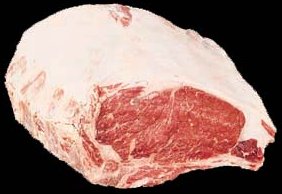 A
whole standing rib roast (prime rib roast) consists of
ribs 6 through 12. Most GOOD butchers recommend that you
request a rib roast from the small end toward the back
of the rib section, which is leaner and gives you more
meat for your dollar. This cut is referred to as the
first cut, the loin end, or sometimes the
small end, because the meat and ribs get larger
as they move up toward the shoulder. A
whole standing rib roast (prime rib roast) consists of
ribs 6 through 12. Most GOOD butchers recommend that you
request a rib roast from the small end toward the back
of the rib section, which is leaner and gives you more
meat for your dollar. This cut is referred to as the
first cut, the loin end, or sometimes the
small end, because the meat and ribs get larger
as they move up toward the shoulder.
I do NOT recommend purchasing a boneless
rib roast, as roasting with the bones adds flavor. But,
if you do purchase a boneless prime rib roast, cook
using the same guidelines as a roast with ribs. Usually
the weight is figured without the bones. If in doubt,
weight your roast before cooking it.
Be sure and check the date the prime rib
was packaged. This is an indicator as to how long it has
been sitting around in the store. Look at the color of
the prime rib; it should have a bright red color and no
dry or brown edges. Check for any damage to the
packaging and wrapping.
Have the butcher cut off the chine bones
from the bottom of the roast and the rib bones from the
meat just along the bone line but do not discard
them. They can be cut off in separate pieces or the
chine bones can be cut off as one piece with the rib
bones. Have the meat placed back on the rib bones and
wrap them along with the chine bones to take home to
cook along with the roast. NOTE:
Having the bones cut away from the meat before cooking
will make carving the finished prime rib a lot
easier.
|
Optional - Dry Aging the
Roast:
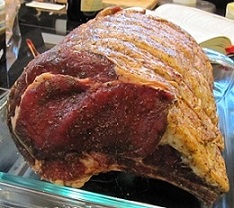 This is optional, but if you have the
time and the space in your refrigerator, you can
dry age the rib roast for several days to bring
out additional flavor and produce a more buttery
texture in prime rib roast (aging allows the
natural enzymes to break down some of protein in
the meat). This is optional, but if you have the
time and the space in your refrigerator, you can
dry age the rib roast for several days to bring
out additional flavor and produce a more buttery
texture in prime rib roast (aging allows the
natural enzymes to break down some of protein in
the meat).
Dry-aged
beef can be expensive to purchase and hard to
come by. Some top-quality butchers will offer
already dry-aged roasts for sell. If you can find
one and can afford one (as they are pricey),
purchase the roast. This will cost your more, so
the decision is yours
A food safety note: Home
refrigerators aren’t as consistent or as cold as
commercial meat lockers. Before aging meat at
home, get a Refrigerator
Thermometer and be sure your
refrigerator is set below 40°F.
How to dry-age beef at home - The
good news is that you can dry-age beef at
home:
Only the
top grades of beef can be dry aged successfully.
Use USDA Prime or USDA Choice from the best meat
source in your area. Buy a whole prime rib roast,
rib-eye roast, or loin strip. You cannot age
individual steaks. Unwrap the beef (do not trim),
rinse it well with cold water, allow the meat to
drain, and pat then pat the meat dry with paper
towels.
Wrap the
roast loosely in a triple layer of immaculately
clean cheesecloth or plain white cotton dish
towels (this will help to draw
moisture away from the meat) and set it on
a rack over a rimmed baking sheet or other tray.
Place the wrapped roast on the bottom shelf of the
refrigerator (which is the
coldest spot in your refrigerator).
Refrigerate for 7 to 10 days (the longer the beef ages, the
tastier it gets). After the first day,
carefully unwrap and then rewrap with the same
cheesecloth to keep the cloth fibers from sticking
to the meat.
When
ready to roast, unwrap the meat and, with a sharp
knife, shave off and discard the hard, dried outer
layer of the meat. Shave away any dried areas of
fat, too, but leave behind as much of the good fat
as possible. NOTE: There can be much waste
as the dried and sometimes moldy meat needs to be
trimmed away before cooking and eating it.
Roast whole or cut into
steaks.
|
Prime Rib Cooking
Chart:
The chart below is only a guide. You must rely on an accurate Meat
Thermometer and start taking temperatures about 45
minutes before the end of the estimated roast time.
Reminder: Instant read thermometers
are not meant to be left in the roast during the cooking
process.
|
What constitutes rare and
medium-rare cooked meat?
To satisfy government home
economists, the Beef Council says rare beef means
an internal temperature of 140 degrees F. Well,
that is ok if you like well-done and dry meat. If
you like moist, rosy meat (like I do), rare begins
at 120 degrees F. and starts to become medium rare
at 125 to 130 degrees F. To cook your meat
properly, you must purchase and use a good
instant-read digital meat thermometer.
 This is the type of cooking
and meat thermometer that I prefer and use in my
cooking. I get many
readers asking what cooking/meat thermometer that
I prefer and use in my cooking and baking. I,
personally, use the Thermapen Thermometer
shown in the photo on
the right. Originally designed for professional
users, the Super-Fast Thermapen
Thermometer is used by chefs all over
the world. To learn more about this excellent
thermometer and to also purchase one (if you
desire), just click on the underlined: Thermapen Thermometer. This is the type of cooking
and meat thermometer that I prefer and use in my
cooking. I get many
readers asking what cooking/meat thermometer that
I prefer and use in my cooking and baking. I,
personally, use the Thermapen Thermometer
shown in the photo on
the right. Originally designed for professional
users, the Super-Fast Thermapen
Thermometer is used by chefs all over
the world. To learn more about this excellent
thermometer and to also purchase one (if you
desire), just click on the underlined: Thermapen Thermometer.
Also
learn How To Test and Calibrate a Cooking
or Meat Thermometer.
|
| |
Approximate
Weight |
Oven
Temperature |
Total Estimated Time
Only |
Meat Thermometer Reading
(Rare) |
|
2 ribs |
4 to 5 pounds |
450 deg/325 deg F |
60 to 70 minutes |
120 degrees F |
|
3 ribs |
7 to 8.5 pounds |
450 deg/325 deg F |
1 1/2 to 1 3/4 hours |
120 degrees F |
|
4 ribs |
9 to 10.5 pounds |
450 deg/325 deg F |
1 3/4 to 2 1/4 hours |
120 degrees F |
|
5 ribs |
11 to 13.5 pounds |
450 deg/325 deg F |
2 1/4 to 2 3/4 hours |
120 degrees F |
|
6 ribs |
14 to 16 pounds |
450 deg/325 deg F |
3 to 3 1/4 hours |
120 degrees F |
|
7 ribs |
16 to 18.5 pounds |
450 deg/325 deg F |
3 1/4 to 4 hours |
120 degrees
F |
How To Check Oven Temperature
- Oven temperatures are not always correct.
In fact, they can often be off by 25°F to 50°F. The will
seriously affect the baking time of your prime rib
(standing rib roast). To check the temperature of your
oven, place an oven thermometer on the center rack and
heat the oven for 15 minutes at 350°F. If, after 15
minutes, the oven temperature reads higher or lower than
your oven setting, adjust your oven setting for your
prime rib baking and for all your future
baking.
|
Beef Roast
Cooking Temperatures
|
|
Rare |
120 to 125
degrees F |
center is bright
red, pinkish toward the exterior
portion |
|
Medium
Rare |
130 to 135
degrees F |
center is very
pink, slightly brown toward the exterior
portion |
|
Medium |
140 to 145
degrees F
|
center is light
pink, outer portion is brown |
|
Medium
Well |
150 to 155
degrees F |
not
pink |
|
Well
Done |
160 degrees F
and above |
meat is uniformly brown
throughout |
High Altitude Baking:
Above 2,500 feet, the atmosphere becomes
much drier. The air has less oxygen and atmospheric
pressure, so cooking takes longer. Use the sea-level
time and temperature guidelines when oven-roasting beef,
as oven temperatures are not affected by altitude
changes.
Allow additional cooking time for your
prime rib roast at high altitude. I can not give you the
exact cooking time. A food thermometer is the only way
to measure whether your roast has reached a safe
internal temperature. In a high altitude environment, it
is easy to overcook meat.
How To
Prepare Prime Rib Roast:
Photos in this section
by
Perrin Kliot,
Berkerley, CA.
Previously Frozen: If your prime rib
roast is frozen, let it thaw completely in the
refrigerator. Remove the roast from the refrigerator
about 2 to 4 hours before cooking to let it come to room
temperature. Depending on the size of your roast, the
time to come to room temperature may vary. I can't give
you an exact time on this. Use your best
judgment!
Room Temperature: To cook evenly, the roast must
not be cold - let it stand at room
temperature, loosely covered, for about 2 to 4
hours. This time can vary depending on how big or
small your roast is. I can't give you an exact time on
this. If you don't let the roast come to room
temperature, if will take longer to cook your roast,
your roast won't cook evenly, and you'll end up with
well-done slices on the end and raw meat in the center.
Use your best judgment on room temperature
times!
Tying Up Prime Rib: It is important
to tie the prime rib before roasting. If left untied,
the outer layer of meat will pull away from the rib-eye
muscle and overcook. To prevent this problem, tie the
roast a both ends, running the cooking
twine parallel to the bone. Most butchers
will tie your rib roast for you - so ask the
butcher!
|
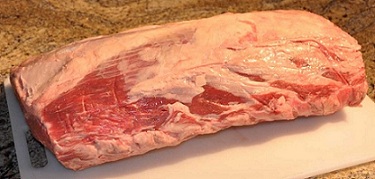
Trim roast
of excess fat, but not the thin layer of fat the
butcher leaves on the roast to protect and baste
it while it cooks. Excess fat means any fat more
than one (1) inch thick. The fat
provides the flavor and what you are paying for
with prime rib, so leave it on.
|

It is important to tie
the prime rib before roasting. If left untied, the outer layer of
meat will pull away from the rib-eye muscle and
overcook. You can cut the ribs away from
the meat leaving only the bottom portion connected
before tying, this makes it much easier to remove
the strings after cooking. Most butchers will cut and tie your
rib roast for
you.
|
|
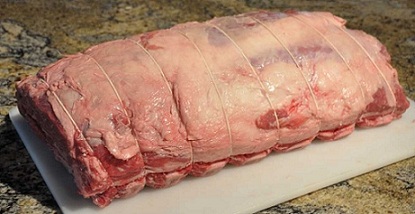
|
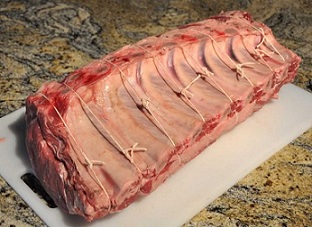
|
|
Tie the
roast at both ends, running the cooking
twine parallel to the bone. Tie the
meat to the rib bones and include the chine bones
at the bottom of the prime rib roast. Tie around
the meat and ribs in between the bones on each
end, making sure to tie the chine bones to the
meat also. Also tie around the meat and bones in
the center of the prime
rib.
| |
|
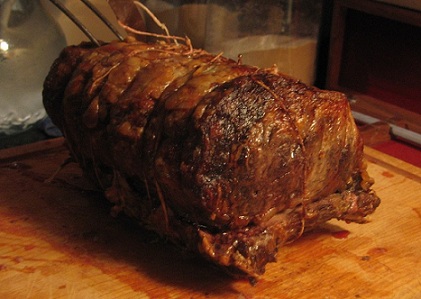
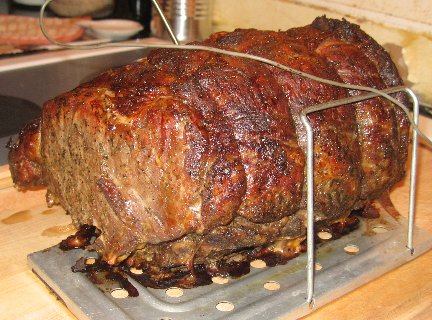
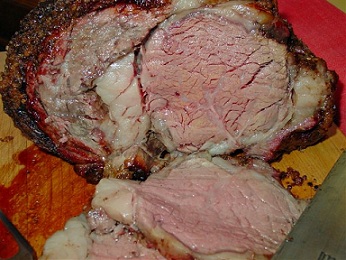
Beef
Recipes:
Beef Recipes using
various cuts of beef.
Prime Rib Roast with
Balsamic Glaze
Standing Rib Roast with Rosemary-Thyme
Crust
Prime Rib
Dinner Menu Ideas:
Prime Rib Dinner (seven-course dinner)
Prime
Rib Dinner
(Thanksgiving Dinner and/or Christmas Dinner)
Prime Rib (Standing Rib Roast) Christmas
Dinner
(five-course
dinner)
Definition
of Prime Rib:
A
tender cut of beef taken from the rib primal. A Prime
Rib Roast is also often referred to as "Standing Rib
Roast." It is very tender, flavorful, and expensive.
A slice of uncooked prime rib roast
is really a "rib steak" which includes the "rib eye"
portion.
Does the grade of the
meat make much of a difference?
You bet it
does - The better the grade of beef, the less
you have to do to it! The higher the USDA grade, the
more you'll pay.
Grading Cuts of
Beef:
Many people have the mistaken idea that the
term "Prime Rib" refers to a roast that is graded
"Prime" when actually the name has nothing to do with
the grade or quality. Most of the roasts sold in
supermarkets that are named "Prime Rib" are graded
"Choice". Prime rib roasts that are graded "Prime" are
usually available only to restaurants or through a
special order with a butcher.
The USDA's grading system gives a good way
to assess quality. The grading designations are largely
determined by the amount of visible fat that's streaked
throughout the muscle tissue, called marbling. Beef
that's richly marbled gets a higher grade; it's more
tender, juicy, and flavorful because the intramuscular
fat melts and bastes the flesh during cooking. Also,
since fat insulates, marbling provides some insurance
against overcooking.
Prime
- The highest grade in the U.S. meat grading system.
Prime has the most marbling and is produced in limited
quantities. Prime beef is most commonly sold in fine
restaurants, specialty meat markets and is exported to
upscale restaurants in foreign countries.
Choice
- Choice has less marbling than Prime but more than
Select. It is typically found in the service meat case
at your local grocery store.
Select
- Select has the least amount of marbling of the top
three grades, making it leaner but possibly less tender,
juicy or flavorful than Prime or Choice. Select is most
commonly found in the self-service meat case at your
local grocery store. Not recommended for top-quality
steaks.
Beware of marketing deceptions where some
grocery stores or supermarkets may try to fool an
unsuspecting consumer by using the words
"prime" and
"choice" without
being attached with the official "USDA
shield."
Unless prime and choice
carries the USDA label, what you are buying may not be
the real thing.
How To Make Prime Rib
Gravy:
Remember - Gravy is different than
Au Jus Juice (see Au Jus Juice below).
After
the prime rib roast (standing rib) is done roasting,
remove from the oven and remove from the roasting pan.
Place
the cooked prime rib on a large Meat Cutting
Board with a well at one end to hold the
juice.
Place
roasting pan over two (2) burners on stove over medium
heat (always make the gravy in the
same pan you used to roast the prime rib roast).
Skim
and discard any excess fat from the juices in the
roasting pan. Using a heavy spoon, scrape all the dark
drippings and any crunchy bits from the sides and bottom
of roasting pan. These are what add
great flavor and a nice rich color to the
gravy.
FOR
EACH 2 CUPS OF GRAVY DESIRED:
Use 3
tablespoons liquid fat (fat is in
the drippings left in the bottom of your roasting
pan)
3
tablespoons all-purpose flour
2 cups
of liquid
(meat
juices/drippings, or broth, vegetable juice, bouillon,
wine, and/or water)
In a
separate container with a lid, shake together
all-purpose flour and about 2 cups cool water. This is called a slurry. Adding the
thickener (flour) in this way helps to prevent lumps
from forming.
Once
the drippings in the pan are lightly bubbling, slowly
add the slurry mixture to the gravy pan, stirring
constantly with a wire whisk. If it
starts to thicken, immediately stop adding the remaining
slurry. You may not need to use all the slurry,
depending on how much or little drippings were left in
the roasting pan.
If
lumps do develop, you should be able to use a wire whisk
to remove them. If all else fails
and you can't remove the lumps, just place mixture in
your blender or food processor and process
until smooth.
If you
gravy is to thick, add additional liquid, stirring
constantly. Season to taste with salt and pepper.
Gravy is
greasy - A Fat
Separator should eliminate this problem. If
you discover that your gravy is oily toward the end of
its preparation, skim off as much fat as possible with a
wide-bowled spoon or a Fat
Separator.
Gravy is doughy
- Make sure the flour in the gravy has been
cooked long enough.
When the flour is added to the pan drippings,
whisk constantly while the mixture cooks until it turns
a deep golden brown and smells nutty. If the gravy tastes floury when you’re
almost finished, turn up the heat to maintain a rapid
simmer for several minutes; then thin it again with more
stock or water if necessary.
Lumpy gravy
- If gravy has lumps, strain gravy just before
serving, using a fine sieve; discard solids.
Another method (my favorite way) is to place
the lumpy gravy in your food processor or blender and
process until smooth.
Leftovers:
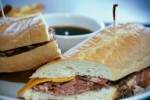
Use any left over Prime Rib and Au Jus for
making French Dip Sandwiches
for your family the next day. So
good! |
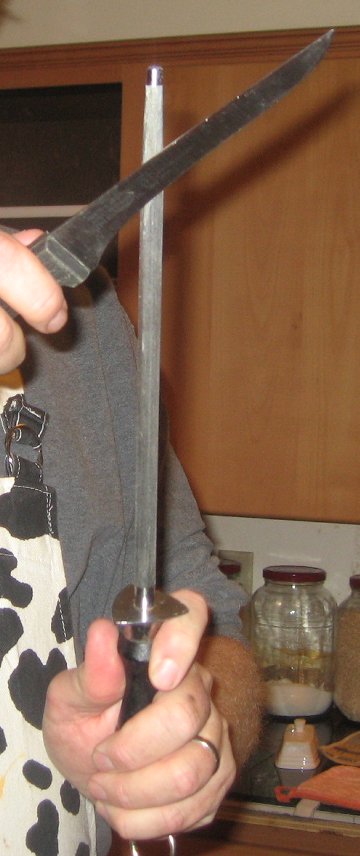 How To Carve Prime Rib Roast: How To Carve Prime Rib Roast:
Use a long, thin, sharp knife. Sharpen you
Carving
Knife, if necessary, using either a
sharpening rod or stone.
Steel Sharpening Rod - To use a Steel Sharpening Rod
or Steel, pull the edge down and across the
rod, holding the carving knife at a 22-degree angle.
Repeat this process anywhere from 5 to 10
times.
Sharpening Stone (whetstones) - To
use a Sharpening Stone
(whetstones), hold the carving knife at a 10-
to 15-degree angle to the stone. Push back and forth in
smooth, steady strokes.
|
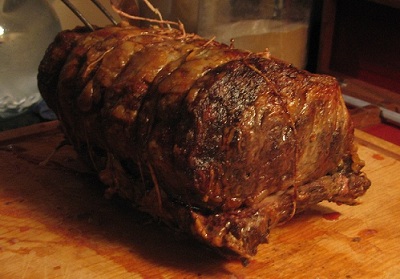
(1) Place the cooked prime rib
on a large Meat Cutting
Board with a well at one end to hold
the juice. Remove the cooking
twine that is tied around the
roast.
|
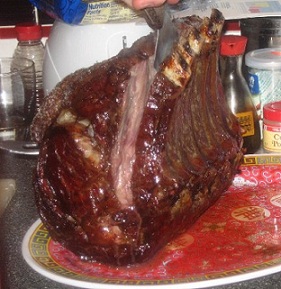
(2) Use carving fork to hold
roast in place. Turn the platter to where the rib
bones are on your left, if you are right-handed,
and on your right if you use your left hand to
carve.
|
|
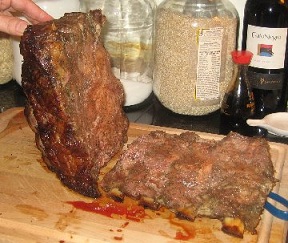
(3) Using your sharp carving
knife, make one cut to slice off the chine or
feather bones (the large-end bones) to sever meat
from bones in one piece. Note:
Save the bones for nibbling on later or for making
delicious soup.
|
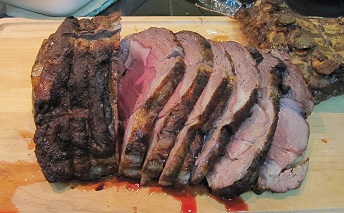
(4) Set roast cut-side down.
Slice the meat across the grain to the thickness
you prefer.
| |
| |
|
Yorkshire
Pudding:
A
traditional English side dish to Prime Rib Roast
is Yorkshire Pudding, a puffy pop-over like
pastry. Yorkshire Puddings, fresh from the oven,
should be well-risen and golden brown with a crisp
exterior and soft middle.
Ingredients:
3/4 cup all-purpose flour
1/2 teaspoon salt
3 eggs, room
temperature
3/4 cup milk, room
temperature
1/2 cup pan drippings from roast
prime rib of beef (beef juices and
oil)*
* If you do not have enough
pan drippings, add melted butter.
At least two (2)
hours or overnight before you will need this
Yorkshire Pudding batter, prepare the batter
(minus pan drippings), and place in the
refrigerator.
Yorkshire
Pudding is cooked after you have taken your cooked
prime rib roast out of the oven and you are
letting it sit for the required resting
period.
In a large bowl, sift
together the flour and salt.
In another bowl, beat together
the eggs and milk until light and foamy. Stir in
the flour/salt mixture just until incorporated and
smooth. NOTE:
The
batter will be like a very thin pancake
batter.
Cover
bowl with plastic wrap and refrigerate at least
two (2) hours (for best results, refrigerate
overnight).
Directions for Cooking Yorkshire
Pudding:
Traditionally Yorkshire
Pudding is made in one large dish or your meat
roasting pan and cut into wedges. For
individual servings, I have found it is much
easier to prepare them in muffin tins or popover
pans. You be the judge of how you would
like to cook and serve them. See photos below.
After you take your cooked
prime rib out of the oven, increase the oven
temperature to 450 degrees F.
Pour the cooked prime rib meat
drippings into your baking pan or muffin tins of
choice. For a popover version, use popover
pans or muffin pans, putting at least 1
teaspoon of meat drippings in the bottom of
each well.
Place the pan or pans in your
oven and get the drippings smoking hot
(about 5 minutes). Carefully take the hot
pan/pans out of the oven.
NOTE: The fat in the popover or muffin tins
should be almost smoking.
Remove
the prepared cold batter from the
refrigerator. Whisk the
batter thoroughly to break down any lumps and add
some additional air.
Quickly
pour the batter into the hot pan/pans on top of
the hot drippings. NOTE: If using popover
or muffin pans, fill 1/3 full. The fat should
sizzle when you pour the batter. Work quickly, so
you don’t lose all the oven heat.
Put
the pan back in oven and cook until puffed and
dry, approximately 15 to 20 minutes. NOTE: Do not
open the oven door during baking.
Remove from oven and serve hot
with your Prime Rib Roast.
Makes approximately 6
individual popovers (depending on size of
pans).
Also check out my web page on
making Yorkshire
Pudding.
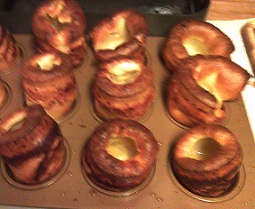
Photo by Jay
McCall
Popover
Style
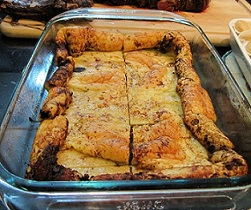
Roasting Pan Style
|
Au Jus Juice:

Au Jus is a French term
meaning "with juice." The term is used to describe
the serving of meat, most often prime rib roast,
surrounded in or served with a container of the
natural juices that were produced as drippings
while the meat was being cooked. It is not thick
like a typical sauce or gravy.
While
the cooked prime rib roast is standing or resting
for the required resting period, make the "au jus"
sauce.
IMPORTANT: Making Au Jus is
more of a technique and not a recipe. You will
have to do this by feel or guess work. It depends
on how much juice is left in your pan (plus the
juice from slicing the prime rib roast), and how
many people you will be serving.
Add your beef broth and/or wine
according to how much Au Jus you think you will
need for each person being served. I wish I could
give you exact directions, but it is impossible to
have an exact recipe for this.
Ingredients:
Beef juices from cooked Prime Rib
Roast
Beef broth/stock*
Red wine (of your
choice)**
* The au jus
will only be as good as your beef stock (and also
the red wine you use), so it is recommended that
you use homemade beef stock, if possible. If you
must use canned stock, buy the best you can find,
but forget about using salty,
artificially-flavored bouillon cubes.
** I like to add
some of the same red wine that I will be serving
with the meal.
Directions:
Pour off all but 2
tablespoons of the fat (leaving the beef
juices in the pan) from the roasting pan and
discard the remaining fat (or reserve if making
Yorkshire puddings).
Place the roasting pan on two
(2) burners on medium heat. Add the beef stock and
stir to release any browned bits in the pan. Add
red wine of your choice.
Bring mixture to a boil and
cook until the stock is slightly reduced, about 5
minutes. NOTE: Au jus is not
thick like a typical sauce or gravy. Season
to taste with salt and pepper.
Transfer to a gravy boat or
serve in small individual containers for each
guest.
Use any left
over Prime Rib and Au Jus for making French Dip
Sandwiches for your family the next day. So
good!
Also
check out my web page on making Beef Au Jus - Au
Jus Beef Juice.
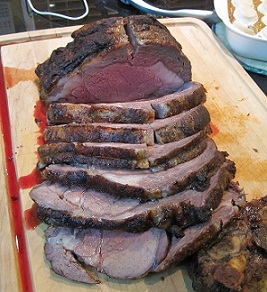
|
Sour Cream Horseradish
Sauce:
This is my favorite sauce to
use with prime rib.
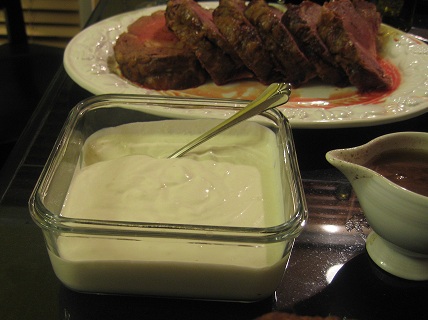
Ingredients:
1/4
to 1/2 cup prepared horseradish (according to your
taste)
1 pint (2 cups) sour cream
2
tablespoons fresh-squeezed lemon juice
1
teaspoon salt
Directions:
In a medium-sized bowl,
combine horseradish, sour cream, lemon juice, and
salt; thoroughly mix. Refrigerate until ready to
serve.
NOTE: Can be
made 2 days in advance. Cover and
refrigerate.
To serve, pass the horseradish
sauce on the side.
Makes approximately 2 1/2
cups.
Garlic
Blue Cheese Sauce:
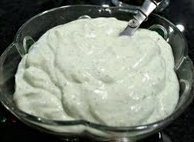 Ingredients: Ingredients:
3/4 cup heavy cream
1
medium garlic clove, thinly sliced
6 ounces
blue cheese, crumbled
Freshly ground black
pepper
Directions:
In a medium-sized saucepan
over medium-high heat, bring cream and garlic just
to a boil. Lower heat and simmer until the cream
coats the back of a spoon, approximately 5 to 10
minutes. Remove from heat.
Stir in the crumbled blue
cheese. Season to taste with the
pepper.
NOTE: Can be
made 2 days in advance. Cover and refrigerate.
Bring to room temperature before
serving.
To serve, pass the Garlic Blue
Cheese Sauce on the side.
Makes approximately 2
cups.
Apple
Horseradish Sauce
Cream:
(low fat version)
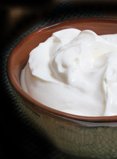 Ingredients: Ingredients:
1/4 cup grated tart
apple
1/4 low-fat plain yogurt
1/4 cup light
mayonnaise
1 teaspoon Dijon mustard
1
tablespoons prepared horseradish
Directions:
In a medium-sized bowl,
combine apple, yogurt, mayonnaise, Dijon mustard,
and horseradish.
NOTE:
Can be made 2 days in advance. Cover and
refrigerate.
Makes approximately 2 1/2
cups.
|
| |
|
I welcome your photos and comments on
cooking your Prime Rib Roast. Contact Linda
Stradley.
2011
Comments from readers:
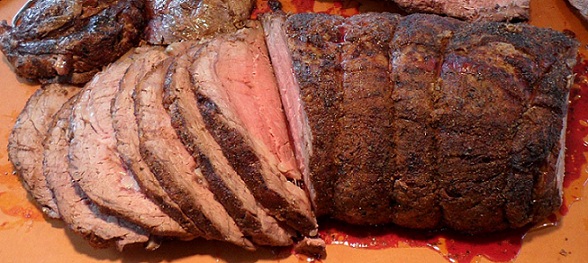 My apologies for not writing
sooner! Last Christmas my husband brought home a
6-bone, PRIME grade, prime rib roast. None of my
recipes told how to deal with such a large roast.
Your web site, instructions and pictures helped us
make and serve The Best Prime Rib EVER! My apologies for not writing
sooner! Last Christmas my husband brought home a
6-bone, PRIME grade, prime rib roast. None of my
recipes told how to deal with such a large roast.
Your web site, instructions and pictures helped us
make and serve The Best Prime Rib EVER!
My friends are still
talking about it and have asked that we make it
again this year! We ended up having to hold the
meat for almost 1.5 hours and thanks to your great
instructions, we knew what to do. It still came
out a perfect medium-rare! I also think it's the
first time we've ever properly carved the prime
rib!
Cannot thank you
enough for sharing your expertise! - M. Jarratt, Huntington Beach, CA
(12/16/11)
I wanted to let
you know that I have never cooked a prime rib
before. I had 20 people over for Pre-Christmas
dinner last year and followed your instructions
and advice and everything came out PERFECTLY! Just
about everyone I invited are self proclaimed
‘foodies’, can cook like you read about. I was
very nervous about cooking for them. They RAVED
about the meat and how fantastic it was. Thank you
very much! I couldn’t have done it without you!
This year, I am having 20 people over again and
will be following your advice to the letter, and
I’m not one bit worried about how things will turn
out. It’ll be just as wonderful this year as last
year. My biggest issue this year has been finding
a Standing Rib Roast big enough. Costco has 18
pound bone-in prime rib – I was looking for a
20lb, but 18lbs will have to do. Thanks so much!
You ROCK! - Tricia Majetich, Jeffersonville, Vermont
(12/05/11)
I just wanted to let you know
that this is the second Thanksgiving in a row that
I've done prime rib-following your instructions.
First year was perfect but this year, even more
perfect because I purchased an aged (28 days) 7
rib prime rib roast from a butcher (last year, I
bought it at Costco). Although I was hesitant to
pay that much, I figured I'm sure it'll be well
worth every dollar! All of my guests were in awe
when they saw this and tasted it. I opted to make
this rare to medium rare. Even for myself, who is
not a steak eater, the meat was so moist and just
heavenly! The only think left over where the
bones! Sad to say that I have no leftover prime
rib to look forward to - but that's okay. I'm
happy as a clam that my splurge was worth it
indeed!! Thank you for your simple but
thorough instructions! BTW, just wanted to share a
photo of my 'at a quick glance' of my time
management of your process! - Marsha Brillantes, Mahwah, NJ
(11/25/11)
I cooked this 10 pound
beauty as instructed on your web page. The only
variation was that I took the roast out at 130
degrees F. because the crowd I was feeding liked
their meat medium-rare to medium. It is so easy
and stress free to make a prime rib now! Thank
You. - Jeff Altzner,
Melbourne,
FL
(2/6/11)
I
purchased a standing rib roast of seven (7) bones.
It weighed in at 13 pounds. It was a small end,
beautiful cut of well-marbled choice plus beef. I
followed your instructions to a “T.” I took my
meat out of the refrigerator at 10:30 a.m. and
inserted my remote digital probe and got a core
temperature of 34 degrees F. By the time I was
ready to put the roast in the oven, it was up to
60 degrees F. I roasted the prime rib for 15
minutes at 450 degrees and then dropped the
temperature down to 325 degrees as planned. I have
to say, it was the best prime rib I have ever
tasted. I did a garlic powder and black pepper
rub. I took my roast out at 135 degrees and the
temperature went up only 3 degrees. It was tender
and juicy! I was also trying to minimize stress,
so I just made the McCormick’s Au Jus. I also made
your horseradish recipe, and it was a hit.
This
morning, I got calls from guests thanking me for
the wonderful day, but ALL commented that they
have never had a better prime rib roast. Also the
CDN remote digital thermometer allowed me to
execute your instructions to perfection. I am glad
I found your prime rib web page to lay it all our
for me. I was confident in the process and the
information that you supplied. Thank again Linda.
– Jeff Altzner
(12/26/10)
Thank you so very much for
the wonderful website full of information for how
to cook a standing rib roast! I had been
searching the internet for directions because,
although I love to cook and cook a lot, I had
never prepared a prime rib. I was having a
formal Christmas dinner for 8 guests and decided
to take the plunge.
Your information was perfect
and so was the prime rib! What was
particularly helpful were the guidelines for
getting a rare roast, which 7 of my guests
requested. (I would have left it in the oven
to 140 degrees as was suggested everywhere else on
the internet). I roasted the meat to about 125
degrees and it was beautiful. I also did not know
that I shouldn't salt the meat, to rub it with
butter, not to use a rack, and to sear the meat at
450 degrees. My guests loved the meal and
there was hardly a bite left on any plate. The
only thing I did differently from your suggestions
was that about ½ way through the roasting process,
I added a small can of beef stock. When the meat
was cooked, I prepared the au jus as you suggested
and it was delicious.
I made my own rub, which I
will share with you: Into about 1/3 jar of
Mrs. Dash Original seasonings, I added 1/4
teaspoon chili powder, 1/4 teaspoon garlic powder,
1/4 teaspoon black pepper, and 1/2 teaspoon sea
salt. I shook all of this together and then
sprinkled some on the buttered roast and saved the
rest.
Thank you
again for the wonderful information, the helpful
photos, and for creating something that is so very
user friendly. I hope your holiday meal was
wonderful too! - Mary Rose,
Longwood, Florida
(1/9/11)
Thank you so much for your web
site. I have had a great deal of anxiety about
cooking for company and much more anxiety about
cooking an expensive piece of meat.
After
reading your article(s) on preparing and cooking
the prime rib (and the extras like Yorkshire
Pudding), I dove into the project with confidence.
I followed the instructions perfectly - from the
buying of the meat, the prep (tying it) and using
a good thermometer. The results were amazing.
We had one of the best New Year's Day meals we
have ever had. At first I thought it was just
my opinion that the meal was good, however, the
compliments were overwhelming - compliments for
taste and presentation too. I will be making this
again! Thanks again for your website. - Jay McCall, Las Vegas, NV
(1/6/11)
I read this web site
front to back and then dove into cooking my first
prime rib. We had 8 people coming over for
Christmas dinner. I bought my rib from Costco
(USDA Choice), a 22 pound whole prime-rib. I
seared it for 20 minutes at 425 degrees then
reduced the temp to 325 degrees. I put a
meat thermometer about 1/3 of the way to the
middle, so if I did error, it would be on the rare
side and not the over-cooked side. We live in
Tucson, AZ , elevation 3,000 feet, so I didn't
know how much that would affect the cooking
time.
I removed the rib
roast from the fridge and let warm to room temp
for a full 4 hours (the center was still around 55
degrees vs. actual room temperature of 70
degrees. I cooked the rib for four hours and
pulled it when the reading reached exactly 120
degrees F. I let it stand for 30 minutes and
the temperature reached 130 degrees before I cut
it.
Results: Everyone
wanted to know exactly what I did because they
couldn't believe how great it turned out. I
cant thank you enough for all the information.
When you pay $130 for a 22 pound piece of beef,
you don't get a second chance. Home Run! -
Forever Grateful - Troy,
Phoenix, AZ (1/5/2011)
| | |